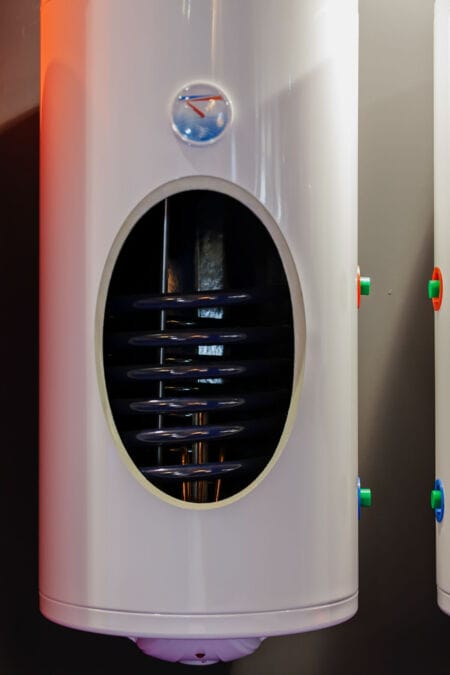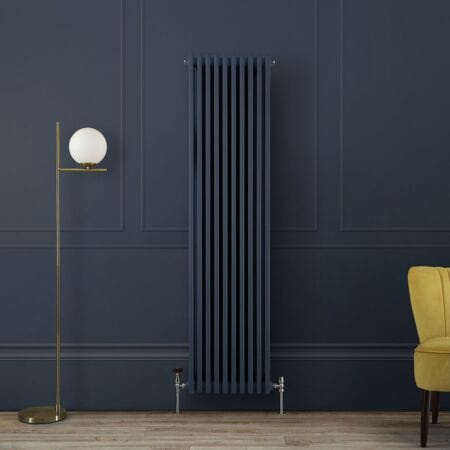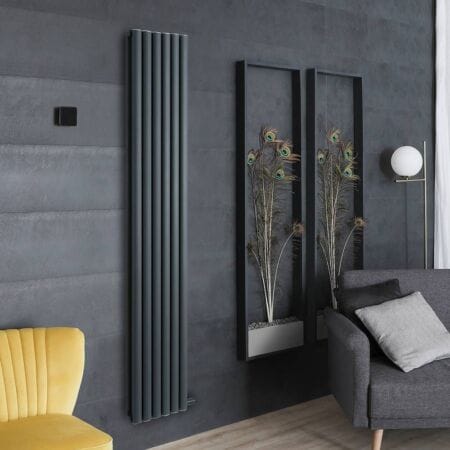Contents
ToggleWhat we'll cover...
Which features, materials and finishes make up the profile of an industrial radiator, and the settings they are best suited to.
Designer industrial radiators with timeless appeal
In the world of interior design, trends come and go. But industrial style radiators? It’s the design equivalent of a Levi’s denim jacket – rugged, timeless, and forever cool.
Whether you live in a converted warehouse or a new-build property with a wealth of design ideas swimming around your head, adding a splash of industrial character is a surefire way to give your space an authentic edge for any heating season. And one of the most underrated ways to do that? You guessed it – an industrial radiator.
More than a simple background boiler buddy, your designer radiator can be a genuine industrial style centrepiece. Especially when you ditch the standard white panel for something a little grittier, heavier, and unapologetically urban. So, let’s dive deep into industrial style radiators, what makes them work, and how to get them heating (and styling up the space) like a pro.
What defines industrial style in interiors?
First things first: what are we even talking about when we mention “industrial style”?
Rooted in converted factories and open-plan lofts, industrial design is all about:
- Raw materials – metal, brick, concrete, wood
- Exposed elements – visible pipework, steel beams, warehouse lighting
- Neutral palettes – blacks, greys, rust tones, and muted textures
- Form follows function – items that do a job and look very good doing it
It’s about embracing the unfinished, the imperfect, and the practical – then making it look intentionally, industrially brilliant.
And your heating can follow suit and complement the overall aesthetic in no small way.
What makes a radiator "industrial"?
Industrial style radiators channel that gritty, robust appearance without any compromise on performance. In fact, they’re some of the hardest-working radiators you can install, all while looking like they’ve just stepped out of a factory in 1950s Brooklyn.
Key traits:
- Chunky profiles – thick columns, solid frames, visible valves
- Muted metal finishes – anthracite, black, aged bronze, bare steel
- Structural simplicity – no flourishes, no curves, no nonsense
- Substance and scale – they don’t shy away from making a statement
The best industrial radiator styles (and where they work)
1. Column radiators - The classic choice
Column radiators are arguably the godfather of industrial heating. With their cast-iron roots and steel rebirth, they offer:
- High BTU output
- Visual heft
- Timeless appeal
Best for:
- Period properties with high ceilings
- Open-plan kitchens and lounges
- Hallways where you want instant character
Opt for 2, 3 or even 4-column radiator models, depending on your heat output needs. Matte black and anthracite finishes deliver the full industrial vibe. Alternatively, you could choose to invest in the classic appeal of cast iron radiators.
2. Vertical radiators - Space-saving showstoppers
Tall, slim, and made to impress. Vertical radiators are an ideal heating choice for modern homes that crave a touch of industrial flavour without crowding the floor.
Why they work:
- Great in smaller rooms or tight spaces
- Add architectural interest to bare walls
- Often powder-coated for a rugged matte finish
Best for:
- Bathrooms, kitchens, alcoves
- Side-by-side with tall furniture or panelling
- Contemporary-meets-industrial interiors
3. Raw metal and bare steel radiators - Real deal texture
Some designer radiators are treated with faux-industrial finishes that mimic a raw steel look. Others go all-in with actual exposed metal.
Best used with:
- Reclaimed wood shelving
- Concrete floors or dark tile
- Vintage-style lighting
Just bear in mind, raw finishes might require a level of extra care to prevent rust, so check the specifications if you’re considering installation in a bathroom or humid environment.
4. Industrial heated towel rails - Bathroom heat with edge
Not all heated towel rails need to retain a standard bathroom-friendly look; a more disruptive and dynamic aesthetic is possible too. Industrial-style towel rails offer:
- Ladder-like designs in matte finishes
- Wider gaps for chunkier towels
- Options in antique brass, copper or black
5. Electric industrial radiators - Off-grid grit
Need to heat a room with no plumbing? Industrial electric radiators can still bring the look.
Look for:
- Lot 20 compliant models
- Pre-filled oil heaters or ceramic core radiators for efficient, even heat
- Smart thermostats for precision and savings
Perfect for garden offices, loft conversions, and extensions where traditional heating isn’t practical, but style still matters.
The finishes that make the look
When it comes to getting the industrial aesthetic right, finish is everything. These tones and textures bring the look home:
Anthracite
The go-to shade for modern industrial interiors. Charcoal grey, matte, and incredibly versatile, anthracite radiators remain an industrial style staple finish.
Matte black
Bold, graphic and unmissable. Matte black radiators work brilliantly against white or concrete-effect walls.
Antique bronze & copper
Providing vintage warmth for those chasing that steampunk/loft hybrid vibe.
Brushed steel
Minimalist but still raw. Think commercial kitchen energy with a bit more polish.
Pro tip: Avoid glossy or chrome radiators if you’re going for a full industrial vibe – it reads too modern or clinical. Go for textures that look like they’ve seen some history.
Energy efficiency: Can industrial radiators pull their weight?
As Mick McCarthy might say, they can.
Many people might assume industrial style radiators are all about looks. But a well-specified industrial radiator is just as efficient as any other, and in some cases even more so.
Here’s what to check:
- Material: Aluminium radiators heat up quickly, steel retains heat longer. Make your selection based on usage patterns.
- BTU output: Use a BTU calculator to size it right.
- Low water content: Some models use less water, so they respond faster.
- Smart controls: Pair with thermostatic radiator valves (TRVs) or a smart thermostat for room-by-room control.
In short: don’t let the rugged looks fool you. Industrial radiators are built to work hard, and if you kit them out properly, they can save you money as well, even as a solid winter heating option.
How to style industrial radiators in different rooms
Some styling options and advice for a stunning industrial aesthetic.
Living room
Go bold with a black column radiator under the window, or a tall vertical number beside a shelving unit. Style with:
- Distressed leather furniture
- Open shelving with exposed fixings
- Warm-toned wood or concrete floors
Kitchen
Blend in a raw steel vertical radiator between units or beside French doors. Looks killer with:
- Matt black handles
- Metal stools
- White walls and metro tiles
Bathroom
Pick a towel radiator in a matte black or bronze finish. Keep accessories minimal: wire baskets, stone soap dishes, and textured towels do the trick.
Bedroom
If you’ve got a minimalist setup, a vertical anthracite radiator adds interest without shouting. Layer with:
- Wool throws
- Wall-mounted lamps
- Simple wood furniture
Industrial heat done right with BestHeating
Industrial interiors are all about character, substance and a deliberate raw edge – and your radiator choice can play a big part in that.
Whether you’re making a bold statement in your kitchen, giving your hallway some rugged appeal, or finishing off a moody loft-style bedroom, industrial style radiators bring real presence. They’re not just functional, they’re foundational too.
And the best part? You don’t have to sacrifice comfort, energy efficiency, or practicality. With the right pick, you get heat with heart, looks with longevity, and the satisfaction of knowing your heating game is just as strong as your interior vision.
Discover all sorts of helpful heating hints such as how to stay warm without turning up the thermostat in our Advice Centre. See how industrial style radiators fit into the biggest home heating trends for 2025, and let us know all about your industrial radiator upgrade in the comments, or tag us in your renovations on Instagram, Facebook or X.
John is a Research Specialist for the Best Heating Advice Centre, where for over nine years he has dedicated himself to demystifying home heating for our customers. He specialises in creating clear, data-driven guides and how-to articles by collaborating directly with our team of certified heating experts and product engineers.
His work, built on a foundation of journalistic research, has helped millions of readers make confident and informed decisions about their home heating. When he’s not breaking down the heat output differentials from radiators to heated towel rails, John fancies himself as a fine football and music connoisseur.









